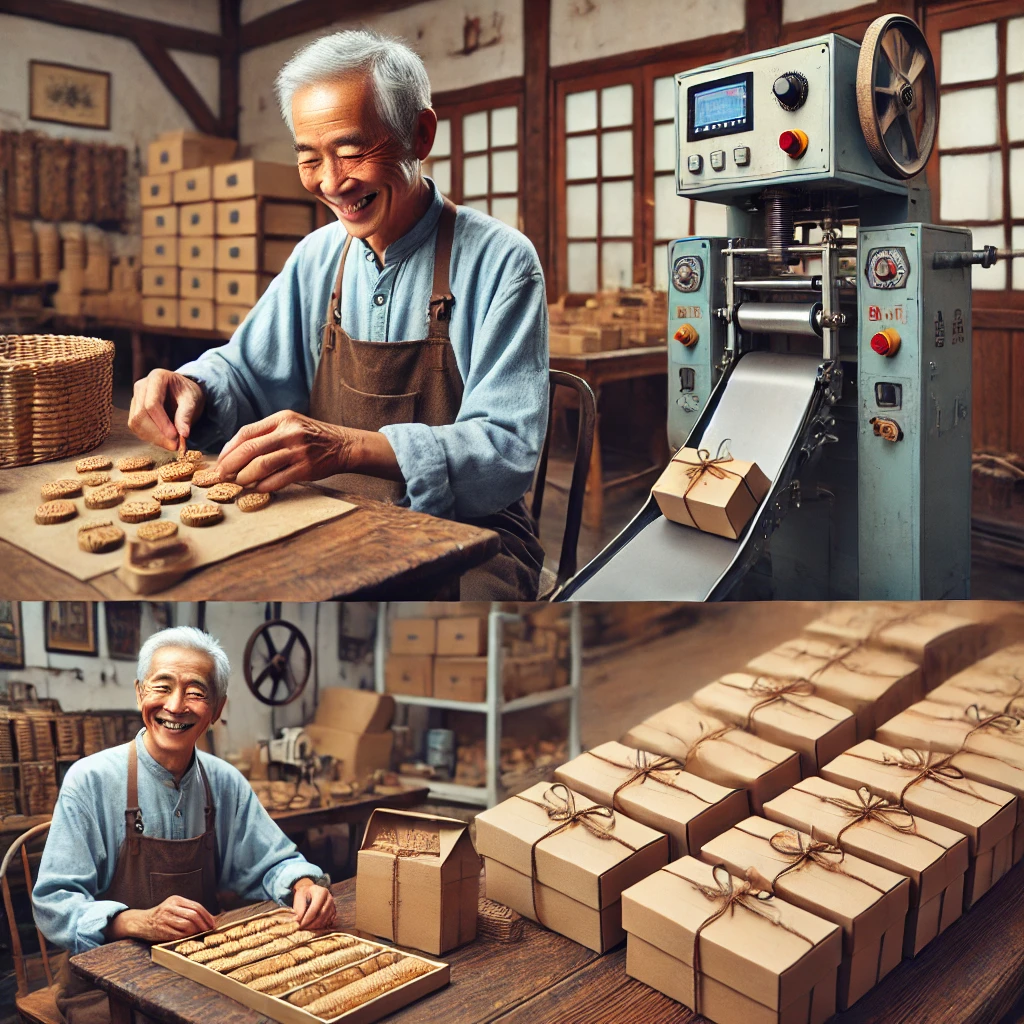
The Harmony Between Handcraft and Technology
In a quiet little town, there was a small factory called “Tiangong Manufacturing.” The owner, Uncle Zhang, was a craftsman who made various exquisite handmade foods, especially his handmade cookies. His cookies were not only delicious but also had unique packaging—each cookie was carefully placed into a hand-folded paper box, tied meticulously with twine, reflecting Uncle Zhang’s love and dedication to his craft.
However, as time went on, Uncle Zhang’s handmade cookies became increasingly popular, and the number of orders continued to grow. In this situation, the once warm and charming manual packaging method turned into a huge challenge. Uncle Zhang found himself working overtime almost every day to complete the packaging process, leaving him with less and less time to actually make the cookies. He was torn; he didn’t want to sacrifice the quality of his handmade packaging due to the increase in sales, but the reality was that the pressure was becoming unbearable.
One day, Uncle Zhang’s friend, Engineer Li, came to visit the factory. Li was a mechanical engineer, and after hearing about Uncle Zhang’s troubles, he suggested, “Uncle Zhang, I know how much you value handmade products, but if you continue like this, you might not only lack time to improve your recipes and production process but also risk losing customers due to late deliveries. Why not try introducing a packaging machine?”
“A packaging machine?” Uncle Zhang frowned. “But how can something packaged by a machine have the warmth and thoughtfulness of handmade packaging?”
Li smiled and said, “Uncle Zhang, technological advancements are not meant to replace craftsmanship but to help us do our work better. I can help you find a suitable packaging machine that can ensure speed without compromising your packaging style.”
Under Li’s persuasion, Uncle Zhang decided to set aside his prejudice temporarily and try the semi-automatic packaging machine recommended by Li. Li found him a machine suitable for small-batch production. This machine could not only seal the boxes automatically but also place the cookies into pre-customized paper boxes.
The packaging machine was installed, and Uncle Zhang started operating it with some apprehension. As the machine ran, he saw each cookie being precisely placed into the paper boxes, and the sealing was also very tight. Everything seemed to be going smoothly, but Uncle Zhang still felt uneasy, thinking that the machine’s operation was too cold and lacked the emotions he put into his handmade packaging.
However, when he looked at the neatly stacked packaged cookies on the table, he began to have a slight change of heart. To test the effect, Uncle Zhang decided to compare the machine-packaged cookies with the ones he packaged by hand. He invited several loyal customers to taste and evaluate the difference in packaging.
Surprisingly, the customers almost didn’t notice any change in the packaging method. They praised the taste of the cookies and said the packaging was still exquisite and warm. Most of Uncle Zhang’s concerns disappeared at that moment. He realized that the machine hadn’t ruined his craftsmanship spirit; it had helped him convey his handmade philosophy even further.
A few months later, Uncle Zhang’s factory underwent a dramatic transformation. With the help of the packaging machine, he finally had more time to research new cookie flavors and improve his production process. The new products were a hit as soon as they hit the market, and the order volume doubled. He no longer had to worry about rushing production affecting product quality, and each batch of cookies could be delivered on time and with high quality.
One day, Uncle Zhang sat in his small office in the factory, sipping tea and watching the machine work smoothly. He was filled with emotion. He suddenly understood a truth: the soul of craftsmanship is not about doing every step personally but about the emotions and dedication he puts into his products. The convenience of the packaging machine lies not only in its ability to improve efficiency and save time but also in allowing him more energy to focus on improving and innovating his products.
From then on, Uncle Zhang no longer resisted machines and technology. He began to proactively learn more about mechanical equipment, thinking about how to use technology to his advantage while maintaining the essence of his craftsmanship. He even shared his experiences with other craftsmen, hoping they could benefit from them.
“Tiangong Manufacturing” products became increasingly diverse and better. Uncle Zhang was no longer the craftsman who worked tirelessly every day, overwhelmed by orders. He still loved handmade work but understood that technology is a friend, not an enemy. It can help him spread his craftsmanship spirit further and wider.
This story tells us that the convenience of a packaging machine lies not only in its ability to improve efficiency and save time but also in allowing craftsmen to have more energy to focus on improving and innovating their products. Modern technology and traditional craftsmanship are not opposites; they can complement each other and create a better future together if used wisely.




